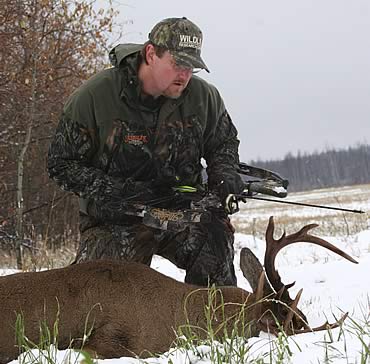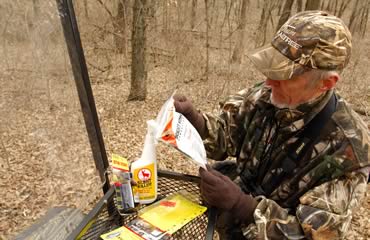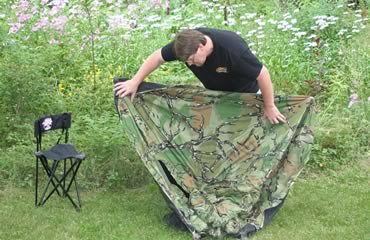Following are a few pearls of wisdom from a professional deer manager and hunter.
Just that quick, things had gone from bad to perfect. The buck, sporting well over 150 inches of antler that had veered off just before hitting my shooting lane, was now being led back on a string. It was poetic justice in a way, since the doe that led him astray in the first place was now working for me. With her coming to a stop within easy shooting distance, I had no doubt I was going to get a poke at this bruiser after all.
Finally, after shredding what seemed like every sapling in the area, he decided it was time to collect his prize. I calmly went to full draw, placed the pin and sent the arrow on its way. So anxious to see the impact, I simultaneously flung the bow to the side to watch the flight of the arrow.
Every bowhunter who’s committed this sin knows the punch line. With the speed of today’s compounds, not only does that act make it impossible to follow the arrow, but the arrow itself rarely comes close to hitting its mark. Four days of exhausting search later, I’d no choice but to resign myself to the fact that I’d never find my buck.
That’s just one example of the many whitetail lessons I’ve learned the hard way. Following are a few more.
 Practice
Practice
As you could guess from the opening story, the most valuable lesson I’ve learned is to practice. Most bowhunters are great at practicing at targets. Unfortunately, that has almost nothing to do with killing deer.
Think about it. When we practice, we’re standing flat footed, on level ground, with the target at a known distance, and we have all the time in the world to shoot. Does that sound like any shot you’ve ever taken at a buck?
That kind of practice serves a purpose. It helps us get sighted in and builds the muscles we need to shoot. After that, it does pitifully little to help us prepare for shooting deer.
Once you’re sighted in, try to make practice as real as possible. That begins by shooting from the types of stands you’ll be hunting from. Since I bowhunt from treestands and ground blinds, I have both set up in the backyard. Shooting from them improves my form and makes me comfortable when using them.
The same can be said for practicing while wearing hunting clothing, in low light, in stiff wind, during light rain and under any other conditions you might encounter while hunting. The time to learn how much lower a wet arrow hits or if the sleeve of your new hunting jacket catches the string is not when Mr. Big is dodging a poorly shot arrow.
Odor Control
If practice is the number one lesson, the benefits of all-out odor control are a close second. Odor control pays for itself over and over in bucks on the wall.
At the risk of offending some, anyone who tells you that hunters can’t consistently beat a whitetail’s sense of smell either doesn’t understand all the steps that need to be taken or is unwilling to take them. I know that’s a bold statement, but I have about 14 years of successfully not hunting the wind to back it up. During that time, despite having numerous deer downwind of my stands on at least a weekly basis, I can count on one hand the number of times I’ve obviously spooked deer from my scent, and I can point to what I did wrong each of those times.
I use the full line of Scent Killer products, I double up on Scent-Lok with both BaseSlayers and outer wear and use the ScenTote storage system.
 However, I don’t believe it’s possible to completely destroy human odor. But we can reduce odor to the point that deer can’t pick it up or it’s so faint that they don’t alarm.
However, I don’t believe it’s possible to completely destroy human odor. But we can reduce odor to the point that deer can’t pick it up or it’s so faint that they don’t alarm.
It isn’t possible to cover everything I do to control scent in this article. Heck, I devoted an overly long chapter in my Bowhunting Tactics book to nothing else. But following are a few things to keep in mind.
First, deer don’t care if they smell your body, breath, boots, grunt tube, release or anything else you bring in the woods with you. If they smell something they don’t like, they’re gone. If you don’t absolutely need an item, leave it in the truck. Second, make sure you treat everything — and I do mean everything — each time before you head out. As ridiculous as it might sound, I wash my glasses every time before hitting the woods. If you want to consistently beat a buck’s sense of smell, you must be thorough. It can be a hassle, but it’s well worth it.
Never Take Shortcuts
As hunters, there are far fewer things we can control than we can’t. The majority of what we can control often seems like minor details. Is it really important to trim that one extra branch in your shooting lane? Is it really that important not to move when that doe has been bedded 20 yards away for two hours and you’ve got an itch on your back? How about walking that extra half mile back to the truck, when you could sneak along the edge of the field undetected most times?
In each of those cases, the odds of something bad occurring by taking the easy route are fairly slim. Unfortunately, when you’re scratching your back and that old doe busts you, she remembers. Now, a week later, when Mr. Big chases her through your first shooting lane and she freezes to stare a hole into you, you just lost your chance to shoot a bruiser buck. And so on. The devil is in the details.
 Don’t Fear Calculated Risks
Don’t Fear Calculated Risks
The other side of the coin is playing it too safe. There are situations when taking a risk is the right move. This is far different from taking shortcuts. Shortcuts are generally taken out of laziness or impatience. Calculated risks are used to take advantage of situations.
A good example is when hunting an ultra hot food source. In most settings, food sources cycle in desirability and availability. Because of that, there’s a window when a food source will be hot before it begins tapering off.
Let’s say an oak ridge is extremely hot for 10 days before the majority of the prime acorns are gobbled up. Conventional wisdom says you should space hunts about four days apart to keep a stand fresh. Is the safe route really the best choice? If so, you’ll get only two prime sits before the deer disperse to greener pastures. On the flip side, if you’re not getting busted, doesn’t hunting the stand every afternoon possible give you a better chance?
If you’re careful about entrance/exit routes and play the wind or take odor control to the extreme, you often can get away with hunting stands for multiple sits without blowing the spot. Heck, even when you do get pegged from a stand, there’s nothing stopping you from shifting to a new tree.
In every situation, weigh the risk against the potential payoff and allow creativity and common sense to lead you. When time and opportunity are limited, it might be the right time to “go for it.”
Complacency Breeds Failure
The mortal enemy of creativity is complacency. We have a strong tendency to try the same tactics over and over again: hunting the same stands and the same plots of ground, and hunting them the same way. When you get positive results, that’s great.
But what if you’ve hunted the same stands on Uncle Joe’s farm for the last five years and haven’t shot a buck? Why would you expect to fill your tag this season? When what you’re doing isn’t working, it’s time to try something new.
And even if you are doing pretty well, try not to become complacent. What happens if Uncle Joe gets an offer for his farm that he just can’t refuse? If you never look for something better, you probably won’t find it. What would you do if your favorite hunting land was suddenly unavailable to you? Always be working on a plan B and a plan C.
Don’t Tolerate Equipment Issues
This one really bugs me. Never settle for substandard equipment or tolerate malfunctioning gear. Murphy’s Law applies to deer hunting.
When that treestand squeaks, don’t wait for the off season to fix it. I can almost guarantee that the next time it squeaks will be when Mr. Big is under your stand or in your sights. Use good-quality gear, and fix anything that is out of order or even hints of failure.
Enjoy Hunting
The last lesson is the most important. Luckily, it’s one I’ve been able to learn from others’ mistakes. No matter how you boil it down, hunting is supposed to be fun. If it’s not, put away your weapon and find something else to do.
In today’s age, we tend to get so wrapped up in antlers that we forget why we got into hunting in the first place. The reasons vary, but don’t forget the thrill and enjoyment that brought you into hunting.
For too many of us, hunting is all about killing the biggest buck. If that sounds like you, slow down and smell the roses. If the advice I give takes away from your hunting enjoyment, don’t use it. While I have fun going to extremes for things like scent control, it’s not for everyone. Just keep in mind that to consistently take big bucks requires a lot of effort. If your goals match your effort, you’ll be a happier hunter.
Editor’s Note: If you like Steve Bartylla’s writing, check out his latest book, “Bowhunting Tactics That Deliver Trophies.” Autographed copies of this hardcover are $30. Send a check or money order to:
Steve Bartylla
1406 St Joseph Ave
Marshfield, WI 54449
Include your name and shipping address.
This article was published in the Winter 2008 edition of Buckmasters Whitetail Magazine. Join today to have Buckmasters delivered to your home.